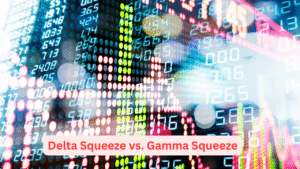 Delta Squeeze vs. Gamma Squeeze: Understanding the Market Mechanics
Delta Squeeze vs. Gamma Squeeze: Understanding the Market Mechanics
In the world of stock trading, options play a powerful and often misunderstood role in shaping price movements. Among the various phenomena that can cause sudden surges or drops in stock prices, delta squeezes and gamma squeezes stand out as two of the most dramatic. Both are related to options trading and the hedging behavior of market makers, but they differ in their mechanics and implications. This article explores the Delta Squeeze vs. Gamma Squeeze in depth, comparing their causes, effects, and real-world examples.
The Basics of Options and Hedging
Before diving into delta and gamma squeezes, it’s important to understand how options work and how they impact stock prices.
An option is a financial contract that gives the holder the right, but not the obligation, to buy (call option) or sell (put option) an asset at a predetermined price before a specified expiration date. The seller or writer of the option is obligated to fulfill the contract if the holder exercises the option.
Market makers—entities that provide liquidity in options markets—often take the opposite side of options trades and hedge their exposure by buying or selling shares of the underlying stock. This hedging activity can influence stock prices, especially in volatile or thinly traded stocks.
Key terms:
- Delta (Δ): Measures how much an option’s price is expected to change per $1 change in the underlying stock. It also reflects the probability that the option will expire in the money.
- Gamma (Γ): Measures how much the delta of an option changes per $1 change in the stock price. Gamma captures the acceleration of delta and plays a key role in gamma squeezes.
What is a Delta Squeeze?
A delta squeeze occurs when there is a surge in buying of call options, especially short-dated or out-of-the-money calls, causing market makers to buy large amounts of the underlying stock to hedge their delta exposure. As the stock price rises, the delta of these options also increases, requiring even more stock to be bought, pushing the price up further.
Mechanism of a Delta Squeeze:
- Traders aggressively buy call options.
- Market makers sell these calls and hedge by buying the underlying stock.
- Stock price rises due to hedging demand.
- As stock price rises, delta of the calls increases.
- Market makers must buy even more shares to maintain a delta-neutral position.
This feedback loop creates a short-term surge in stock price, even if no fundamental news has changed.
Key Characteristics:
- Driven by initial call buying.
- Requires a high level of speculation.
- Can occur in stocks with low float or high volatility.
- Usually short-lived and potentially followed by a sharp reversal.
What is a Gamma Squeeze?
A gamma squeeze is a more explosive version of the delta squeeze. It occurs when the gamma of options positions is high, meaning delta is changing rapidly with the underlying price. This leads to a self-reinforcing cycle where market makers must continuously buy more stock as the price rises to adjust their delta hedge.
In a gamma squeeze, the rate of change of delta (gamma) becomes the key driver. The effect is more intense when there’s a large open interest in short-dated options near the money.
Mechanism of a Gamma Squeeze:
- Large number of near-the-money calls are bought.
- Market makers hedge by buying the stock.
- As stock rises, delta of these options increases rapidly due to high gamma.
- Market makers must buy more stock faster to keep hedging.
- The process accelerates, leading to a parabolic price move.
Key Characteristics:
- Occurs when gamma is high, typically near expiration.
- Requires a large concentration of options positions.
- Strong feedback loop due to rapidly changing delta.
- Often triggered by retail traders or coordinated buying (e.g., Reddit-driven stocks).
Delta Squeeze vs. Gamma Squeeze: Key Differences
| Feature | Delta Squeeze | Gamma Squeeze |
|---|---|---|
| Trigger | Call option buying | Rapid change in delta (high gamma) |
| Hedging action | Market makers buy shares to hedge delta | Market makers buy shares quickly to hedge changing delta |
| Feedback loop | Slower and linear | Faster and exponential |
| Duration | Short-term | Often even shorter, more intense |
| Risk | High for late buyers | Very high; price reversals are common |
| Common in | Volatile, low-float stocks | Stocks with massive call open interest |
Delta Squeeze vs. Gamma Squeeze: Real-World Example: GameStop (GME)
The most well-known example of a gamma squeeze took place with GameStop (GME) in January 2021. Retail traders on Reddit’s WallStreetBets began buying massive amounts of short-dated call options on GME. Market makers, needing to hedge their exposure, began buying shares. The rising stock price led to increased deltas on the options, causing even more stock purchases due to gamma exposure.
This gamma-driven feedback loop resulted in GME skyrocketing from around $20 to nearly $500 in a matter of days. The event had all the hallmarks of a gamma squeeze, not just a delta squeeze, because the acceleration of hedging demand was so intense.
The Role of Short Interest
While delta and gamma squeezes are driven by options dynamics, high short interest can add fuel to the fire. When traders are short a stock and it begins to rise sharply due to a squeeze, they may panic and cover their positions by buying shares—this is a short squeeze. When a gamma squeeze and a short squeeze happen simultaneously, it can cause explosive upward moves.
Risks and Takeaways for Traders with Delta Squeeze vs. Gamma Squeeze
Both delta and gamma squeezes can be profitable but are highly risky, especially for those jumping in late. These events are often driven by technical mechanics rather than fundamentals and can reverse just as quickly as they began.
Tips for Traders:
- Understand the role of open interest and expiration dates.
- Track implied volatility and gamma exposure using tools like options chains.
- Be cautious of chasing parabolic moves—it’s easy to get caught on the wrong side.
- Remember: if you’re hearing about a squeeze in the news, it may already be over.
Delta Squeeze vs. Gamma Squeeze: Conclusion
In the complex world of stock trading, understanding the nuances between a delta squeeze and a gamma squeeze can give investors and traders an edge. While both involve options-driven buying pressure that forces market makers to hedge, gamma squeezes are more extreme due to the compounding effect of changing delta. Whether you’re a retail trader or a professional, grasping these mechanics can help you navigate—or avoid—the high-stakes volatility they create.
